Florida Orchids
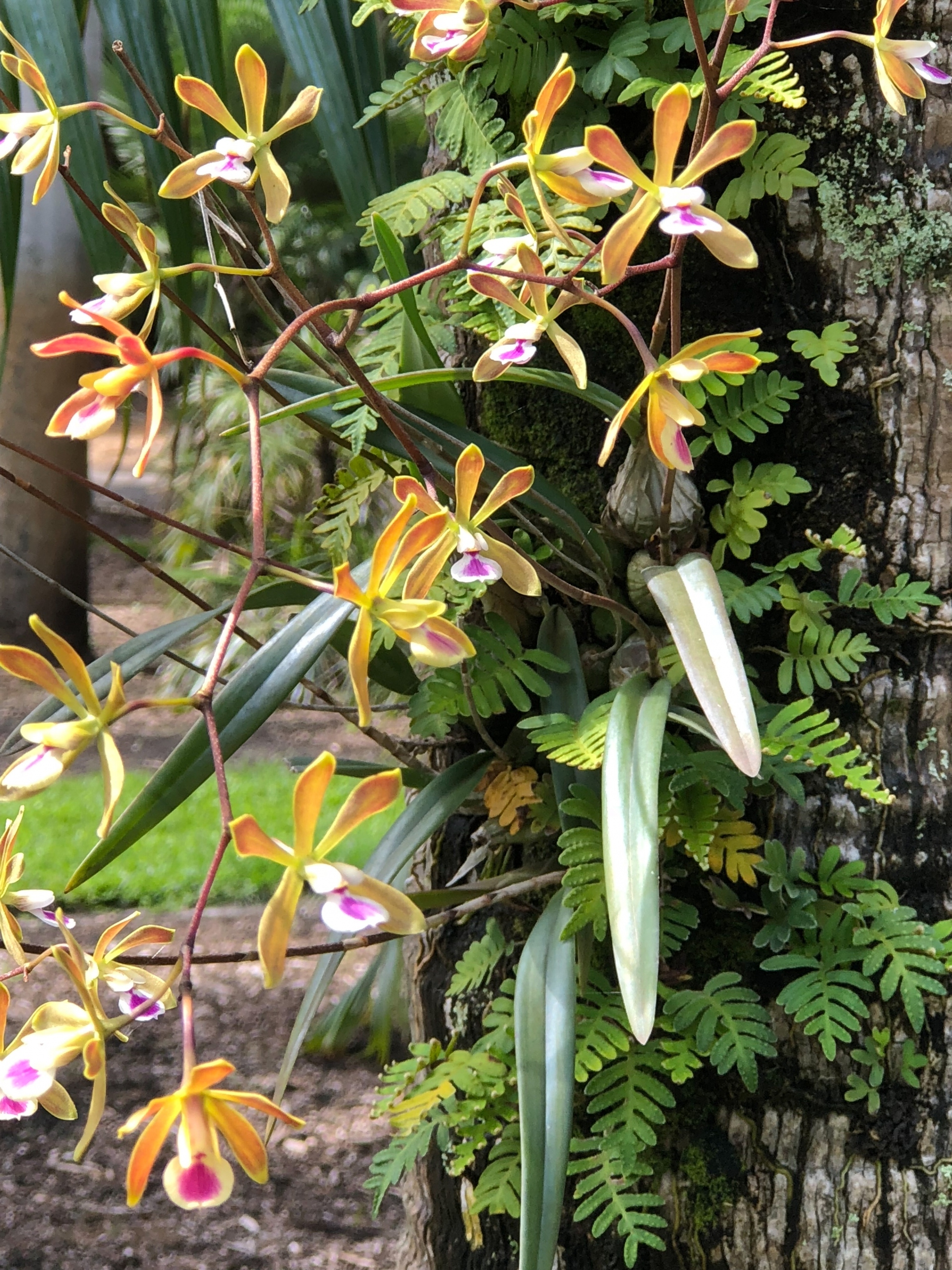
Florida is a truly special environment for orchid species to flourish. Out of the roughly 200 species of orchids known to grow in the United States, about half of those are native to Florida, with about 50 of those growing only in South Florida.
The peninsula of Florida extends south into the Gulf of Mexico, crossing a threshold into warmer subtropical climate conditions ideal for tropical orchid species to thrive. This transitional habitat is called an ecotone and represents a place where two biomes come into contact – in this case, the more temperate Northern Florida and subtropical Southern Florida – meaning that this region supports diverse native species of not only animals like crocodiles, lizards, snakes, turtles, and alligators, but also tropical native trees and flowering plants, like orchids.
Florida’s native orchids have long been threatened by habitat loss and poaching by orchid hunters, but Fairchild’s Million Orchid Project aims to restore some of the unique native species found in Florida.
Shop Orchids in the Fairchild Plant Store
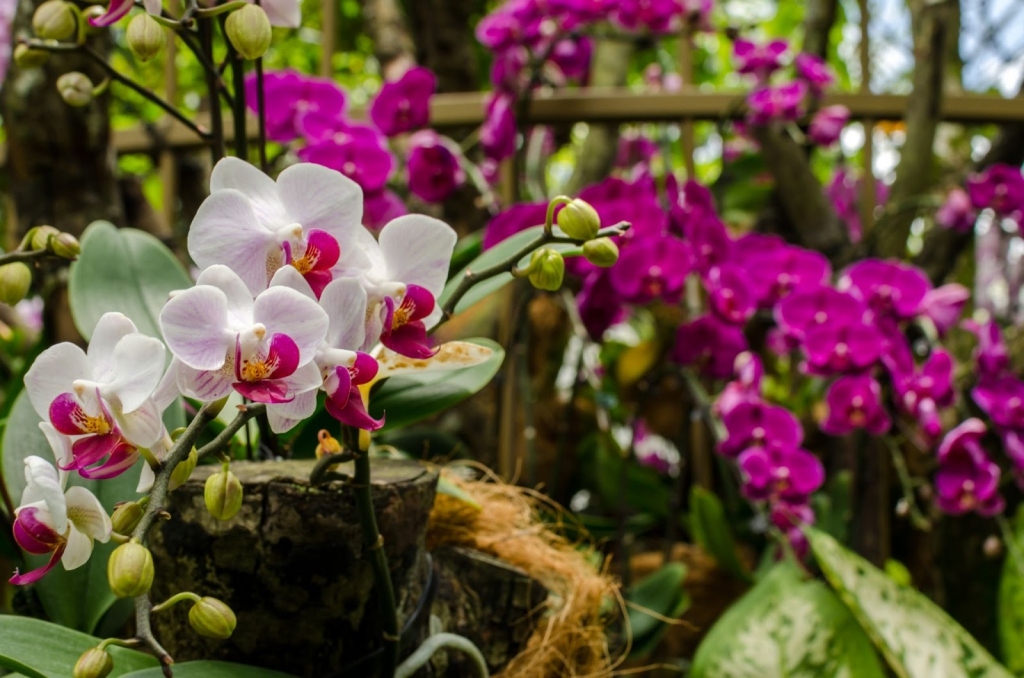
Florida Native Orchids
Because of the fantastically rich diversity of these amazing plants in Florida, there are too many species to comfortably list here. However, below are a few that are either notable for their commonality or rarity, some being among the most sought-after flowering plants in America.
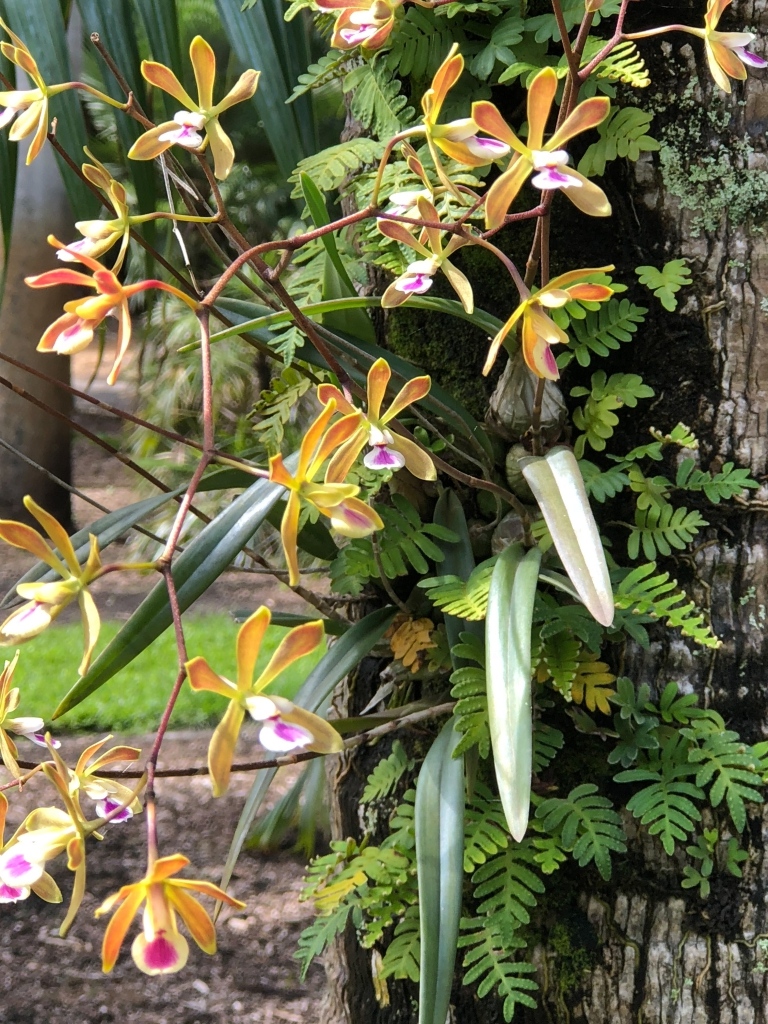
Encyclia tampensis (Florida Butterfly Orchid)
The Florida Butterfly Orchid (or Tampa Butterfly Orchid) is found in not only its namesake state of Florida but also the Bahamas and Cuba. In Florida, you’re most likely to find it in the south and central parts of the state. It features greenish or bronze-colored petals around a white lip with a purple dot. This plant is an epiphyte, attaching to live oaks, mangroves, cypress, and more in its natural habitat.
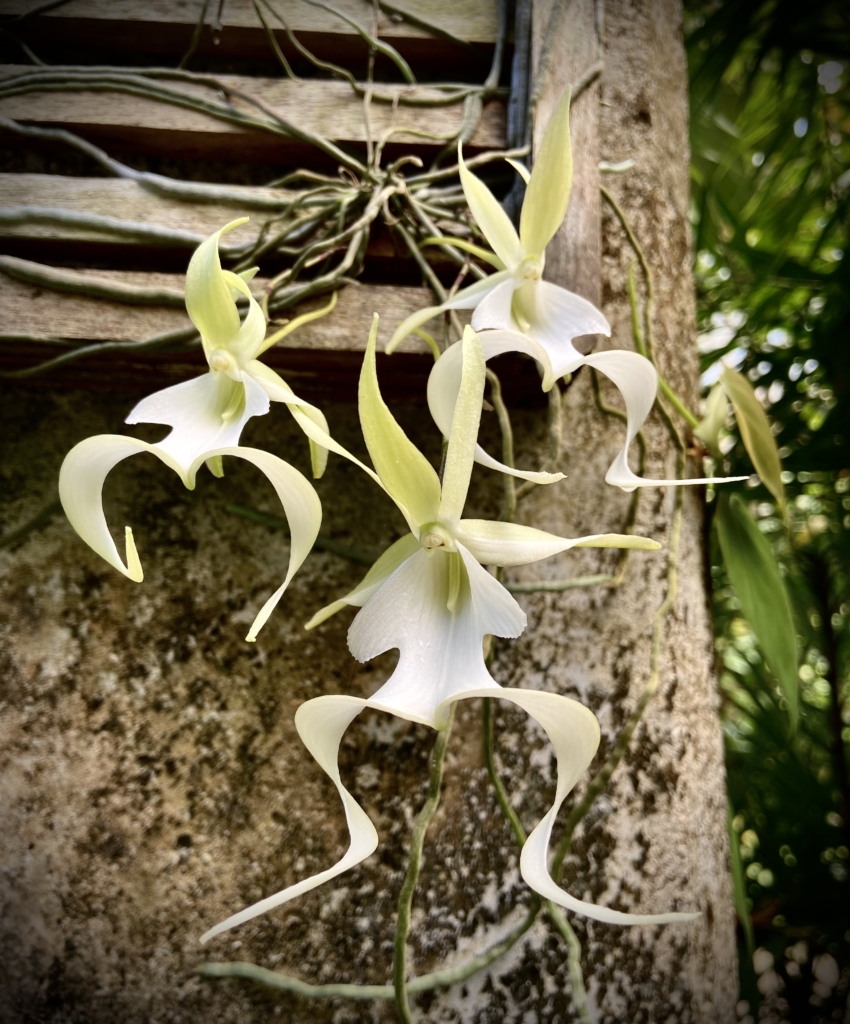
Dendrophylax lindenii (Florida Ghost Orchid)
The extremely rare Florida Ghost Orchid is known for its delicate white flowers with corkscrewing petals. Native to Florida, Cuba, and the West Indes, the Ghost Orchid is an epiphytic species that flowers in the summer. The Florida Ghost Orchid is endangered in the wild, and notoriously, they do not do well after being removed from their natural environments and resist attempts at cultivation. Because of this, it was famously featured as a target of orchid hunters in the novel The Orchid Thief and the movie based on the novel, Adaptation.
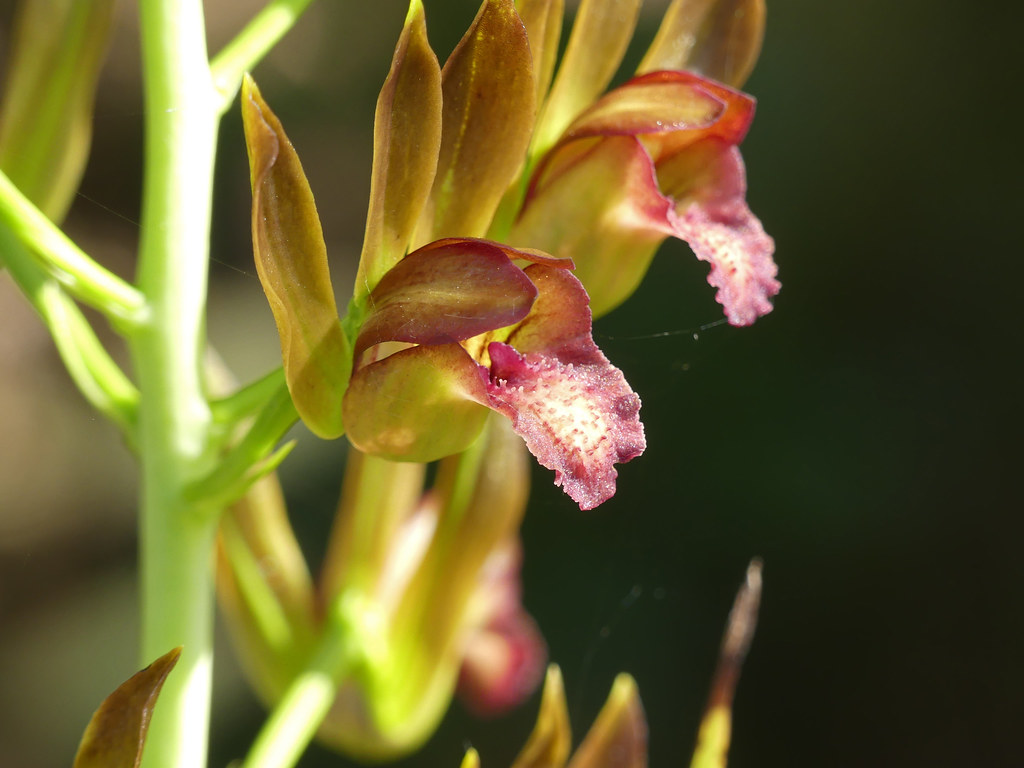
Eulophia alta (Wild Coco Orchid)
The Wild Coco Orchid is known to Florida, Georgia, South & Central America, Mexico, the West Indes, and even Africa. This terrestrial orchid produces one to four leaves on the stem with beautiful pink flowers that can also range from light green to deep crimson. Wild Coco Orchid flowers are known for having “ears” that appear to point up like an alert dog’s. The Wild Coco Orchid can be found in a wide variety of habitats. Generally, the Wild Coco Orchid prefers moist soil near riverbanks, drainage ditches, low-lying forest floor areas, and wetlands.
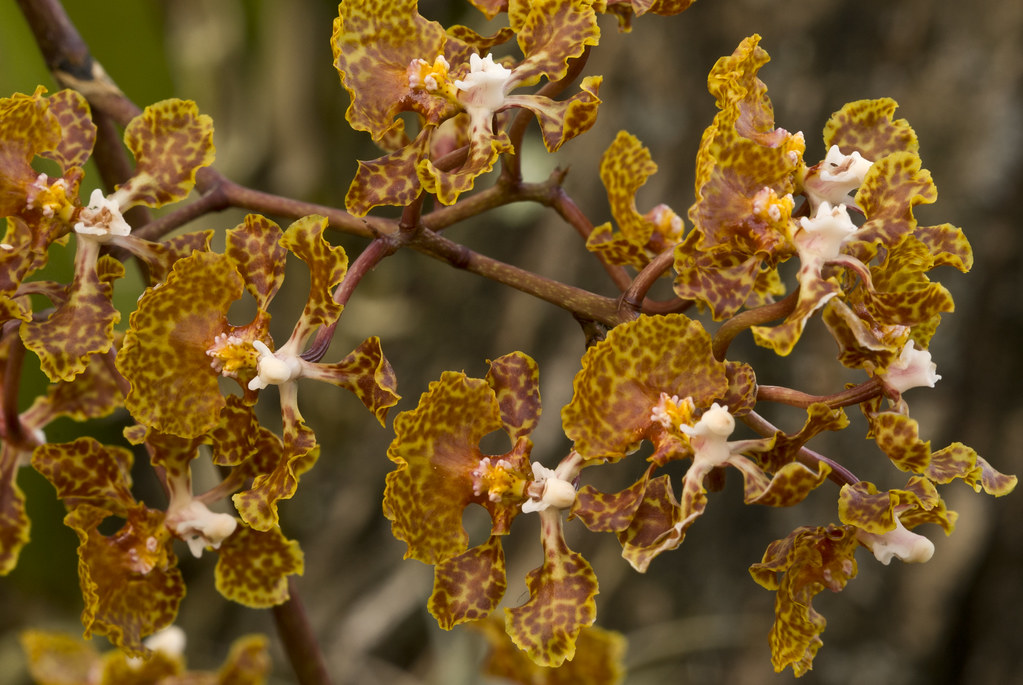
Trichocentrum undulatum (Spotted Mule Eared Orchid)
The Spotted Mule Eared Orchid is found all around the Gulf of Mexico and Caribbean, known to Florida, the West Indies, and Central/South America. Its flowers are a mottled brown-green color with a bright purple-pink center. It is rare in the wild in Florida, found only deep in the Everglades.
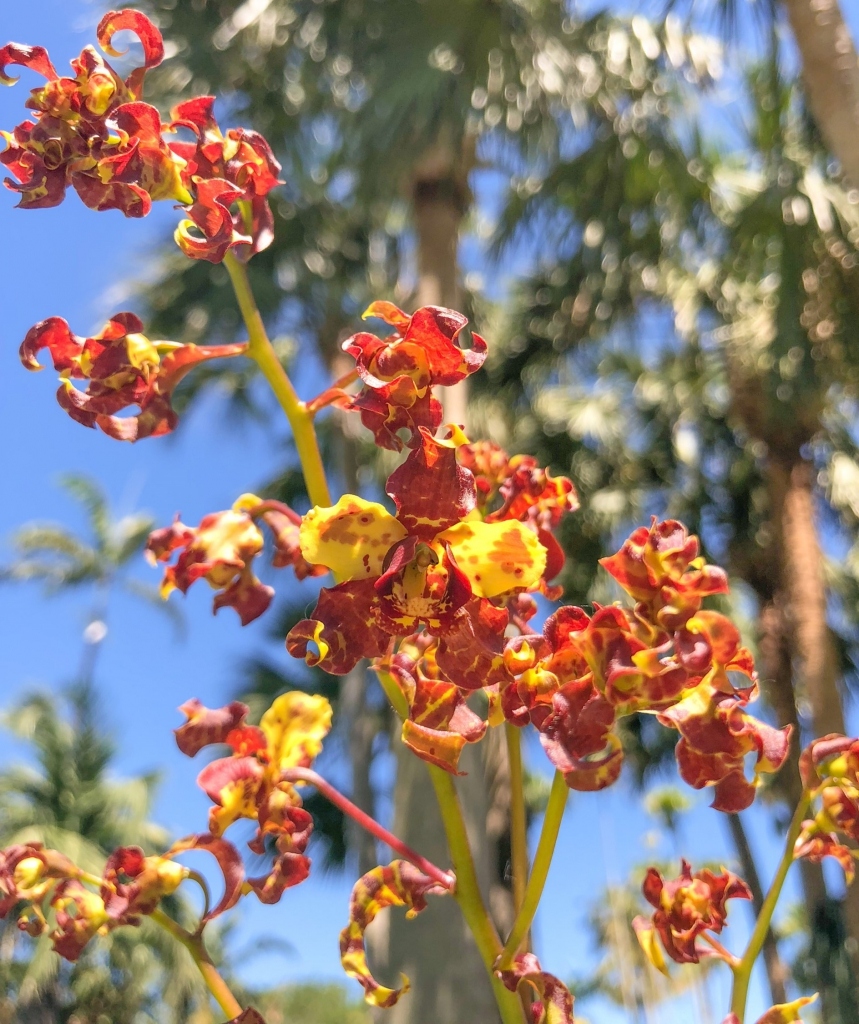
Cyrtopodium punctatum (Cigar Orchid)
Also known as the Cowhorn Orchid, Bee Swarm Orchid, and Cigar Orchid, Cyrtopodium punctatum‘s flower has pale yellowish-green sepals with purple spots, brighter but similarly colored petals, and a lip with ruddy brown-orange marks. Populations of this epiphytic orchid can be found in Mexico, Argentina, and Florida. A mature cigar orchid plant can grow very large undisturbed in the wild, reaching 2+ feet in diameter with potentially hundreds of yellow flowers – a truly massive cigar orchid.
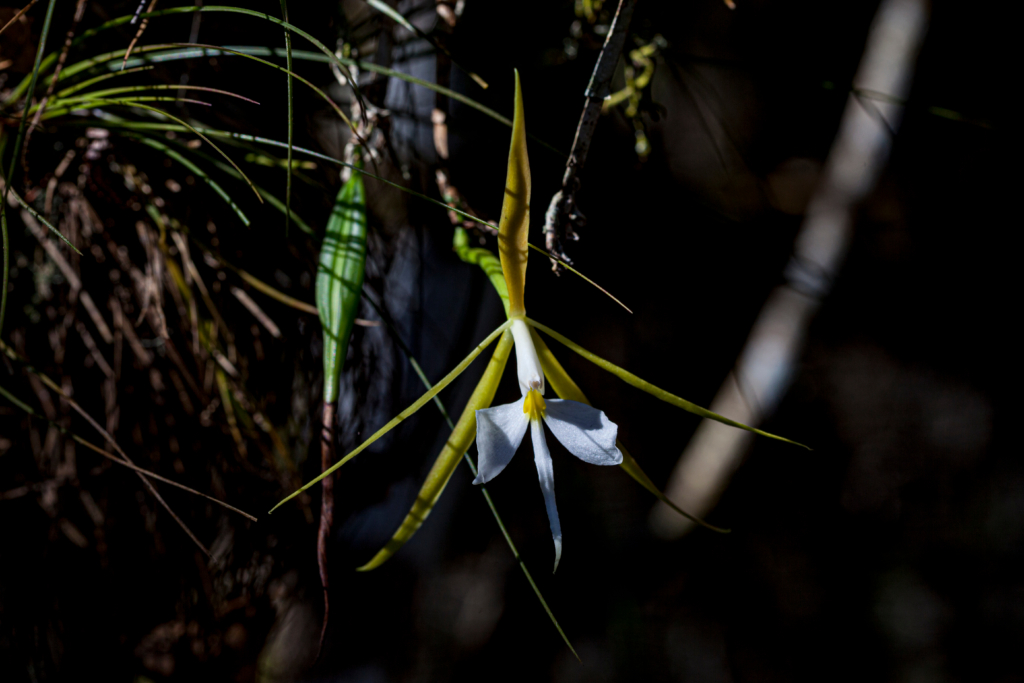
Epidendrum nocturnum (Night Fragrant Epidendrum)
Known as the Night Fragrant Epidendrum, this variety features long, slender, dramatic flowers with yellowish sepals and a three-lobed white lip. While this species is doing well in the West Indies, Mexico, Central America, and northern South America, it is endangered in its native range in Florida.
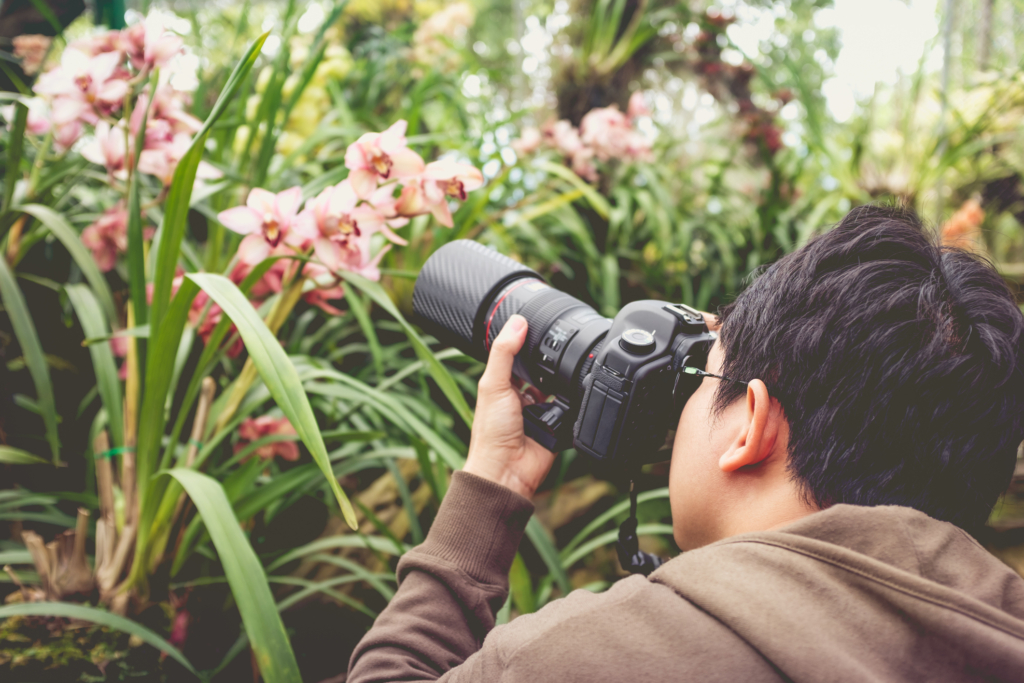
Viewing Orchids at Fairchild
At Fairchild, our experts focus their attention on orchids from all over the tropics with particular emphasis on orchids of cultural and breeding importance and orchid species from Florida and the Caribbean. This renewed focus on the orchid collections at Fairchild Garden was largely due to the partnership with American Orchid Society (AOS) and the public enthusiasm for the Million Orchid Project Program.
The Million Orchid Project
The Million Orchid Project is the largest community-driven outreach program of its kind.
The Million Orchid Project involves not only growing native orchids from seed at the Fairchild Science Village Orchid Lab but also working with the local schools and community to grow Florida native orchids in their gardens and public spaces. The project emphasizes about 10 species out of roughly 100 Florida native species; these were selected because they are hardy plants that can handle drier and hotter conditions within the urban environment.
One such species is Florida’s native butterfly orchid, Encyclia tampensis, which is perfectly suited for growing in the city was also the most common before urbanization. However, outside of the Million Orchid Project, Fairchild houses thousands of seeds, species, and hybrids from our breeding programs and seed library.
This research has been driven by our students and scientists who work tirelessly to propagate orchids, catalog the orchid seeds, understand the genetics, and plan where they’re ultimately going to end up in the garden or in the community.
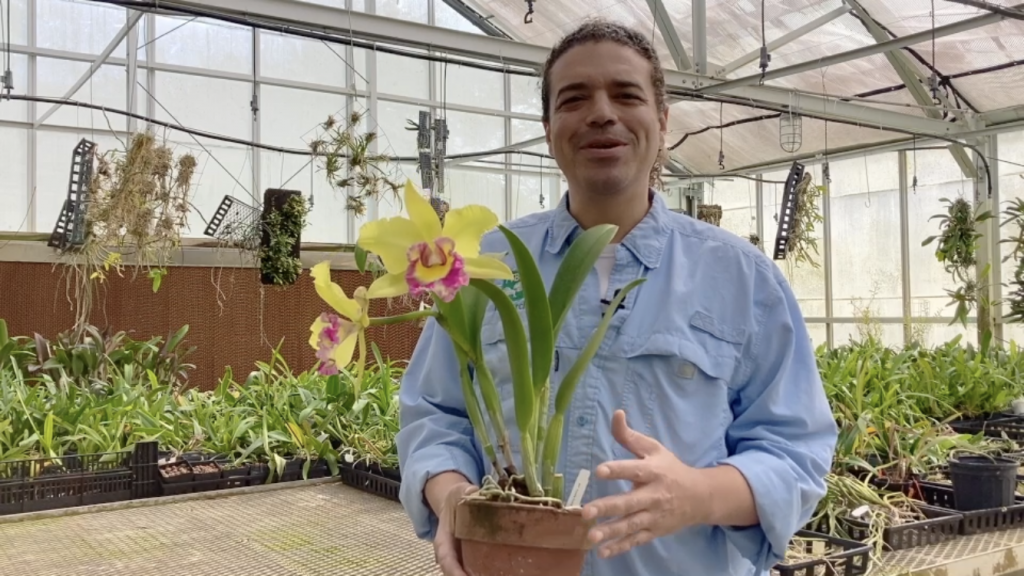
Orchid Exhibits at Fairchild
Fairchild Tropical Botanic Garden is unique in that we’re the only botanic garden permanently attaching the majority of our orchid collection outdoors on trees in a “natural context.” In other gardens, like the beautiful Singapore Orchid Garden, they are refreshed as potted plants or taken out of greenhouses temporarily to be displayed to guests. For gardens in the temperate north, the conditions are too cold to grow most orchids outside of the greenhouse. Since 2018, Fairchild’s historic orchid collection, donated by the American Orchid Society (AOS), has been on public display for the first time.
Nearly 50,000 orchids throughout Fairchild are tree-attached, with roots that anchor them to the bark of a tree. Varieties whose roots attach to tree bark are called epiphytes, or epiphytic orchids. These are mostly restricted to the tropics and subtropics. Outside of the tropics, orchids grow exclusively on the ground with roots in the soil (these are referred to as terrestrial orchids, although they also can be found on the ground in tropical environments).
At Fairchild, you can discover our orchids in three core exhibits in the “uplands.” Each exhibit is in a different plot, and they each have a theme.
Tropical Orchid Rainforest
Inspired by the National Orchid Garden at Singapore Botanic Garden, we will install tens of thousands of orchids in dense arrangements on every tree and branch throughout our existing rain forest plot, creating a world-class visitor experience and a trial garden for experimentation with new hybrid varieties and student research. This exhibit will be the permanent home for the AOS Heritage Collection which is currently being housed at the Fairchild nurseries and is not presently accessible to the general public. Since March of 2019, we have installed tropical varieties including the genera Phalaenopsis, Dendrobium, Vanda, Epidendrum, and Oncidium.
Caribbean Jewels
This exhibit will consist of a comprehensive collection of Caribbean species (>100 species) to be installed in Fairchild’s Palmetum plot. There is a particular local interest in Bahamian and Cuban species with an emphasis on the genera Encyclia, Broughtonia, and Laelia. These species will represent a diverse collection for research and ex-situ conservation and will be of particular interest to local communities.
South Florida Native Orchid Hammock
This collection will be designed to represent the historical landscape of Miami and will house the most comprehensive outdoor collection of Florida native orchids (40-50 species) in the US. Most are considered threatened or endangered in the state (Florida Department of Agriculture and Florida Natural Areas Inventory). The exhibit will be located in Fairchild’s existing native oak hammock plot. Planting designs will be implemented to represent the natural growth habitat and create a unique teaching tool to showcase how orchids thrived before the human impacts that began in the late 1800s.
As a result of our leadership and expertise in orchid propagation, education, and conservation we are also uniquely positioned to provide resources to other botanic gardens to diversify and sustain their orchid collections.
Shop Fairchild-Grown Orchids
Florida Orchid FAQs
Below are some commonly asked questions about orchids in Florida native orchids.
Are there any orchid species native to Florida?
Yes! See the list above for information about a few of Florida’s many orchids.
How many native orchids are in Florida?
Roughly 100, about 50-60 of which are native to Southern Florida. There are only about 200 species of orchids in the entire continental US, making South Florida an orchid hotspot with a disproportionately high diversity of orchids. From the perspective of an orchid fanatic, Florida is the place to be; temperate meets tropical in a transitional ecosystem known as an “ecotone,” fueling diversity and evolutionary experimentation.
What are the best orchids to grow in Florida?
The answer depends on where you are in Florida and whether you intend to grow your orchid indoors or outdoors. If you’re in South Florida, you can grow terrestrial (ground-based) or epiphytic (tree-attached) orchids, particularly those that are native to Florida. If you’re in North or Central Florida, you’ll be limited to terrestrial orchid plants because frosts kill tree-attached orchids. Research your species to determine how to plant it and how to keep it alive!
Do orchids do well in Florida?
Yes! Florida is home to many species of orchids. If you select a native species and introduce it to an environment that mimics its native habitat, your plant can do well. Research the orchid that you’re attempting to grow so that you set yourself up for success!
How do you care for orchids in Florida?
Know your orchid! You can grow lots of orchids in South Florida, probably half of the orchid species in the world (even more if you have a greenhouse). Tropical orchids are generally commercially available in Florida, and each one will require different care depending on the type of orchid they are.
Native orchids and those from the Caribbean will not require long-term maintenance. However, orchids from outside Florida will require maintenance, particularly truly tropical orchids, which will require additional fertilizing, possibly supplemental watering, and protection from periodic cold or frost. Some tropical orchids from, for example, Brazil might not tolerate temperatures in the 50s Fahrenheit, let alone the 40s – temperatures which are common even in the southernmost reaches of Florida.
Where can I find wild orchids in Florida?
Wild orchids grow in a variety of habitats. Tree-attached orchids, or epiphytic orchids, are found in the subtropical part of Florida, mostly in the Everglades. Terrestrial orchids are found in low-lying wet areas, such as swamps or on the forest floor, and grow throughout Florida.
What is the Ghost Orchid?
Dendrophylax lindenii, also known as the ‘Ghost Orchid’, is a mesmerizing and rare epiphytic orchid native to Florida and Cuba. It boasts delicate, white, and often translucent flowers that appear to hover in the air, making it a stunning addition to any collection of botanical wonders. This orchid typically lacks leaves, relying instead on a complex root system to derive nutrients and moisture from its surroundings.
As captivating as it is, it’s crucial to note that growing and caring for Dendrophylax lindenii can be challenging, especially for beginners. This orchid thrives in specific habitats such as remote swamps and hammocks, making it sensitive to environmental changes and requiring precise care conditions.
How do you take care of native Florida orchids?
When it comes to Florida’s native tropical orchids, select the right tree and the right conditions for the species. Identify the species you’re dealing with to know whether it’s shade-loving, partial shade, or full sun. When first establishing an orchid plant, make sure it’s attached bare-root on the tree bark and fastened tightly to the tree – this allows it to attach its roots naturally. When first establishing a plant, water it every day for a good two weeks. After 2 weeks, you can slowly wean the orchid off water; by week 3, water every other day. At week 4, water it every 3 days, and after a month, there’s no need to keep watering.
How do I know what kind of orchid I have?
There are some great websites and apps out there to help identify plants. Try Pl@ntNet https://identify.plantnet.org/. If you’d prefer something physical, pick up a reference book for orchids – there are quite a few of them out there. For Floridians, we recommend “Florida Orchid Growing Month-by-Month.”
If you’re still unsure even after picking up a reference book or checking online, keep it alive until it flowers – the flowers can have traits that are easier to use for identification purposes than just the leaves of the plant. Generally, you’re likely to have one of the more commercially available orchids rather than a rare wild species, which can help you narrow your possibilities.
If you’re still at a loss after all of these tactics, reach out to your local botanic gardener if you don’t know and they can help you.
What is the secret to growing orchids?
You need a special lab to grow an orchid from seed, so growing an orchid in this way is not possible for the home enthusiast. However, if you have a starter plant, it’s as simple as knowing your orchid. For the tree orchids that are growing in substrate rather than attached to bark, the most important thing is to make sure you let your orchids dry down between watering.
In the wild, orchids on trees dry out as soon as the rain stops. Try to mimic this by letting them dry completely before watering. A sign that you’re not letting them dry enough is that the roots may start to grow out of the pot to escape the wetness. This is more important for the tree species than ground species.
What time of year do orchids bloom in Florida?
Native orchids in Florida mostly bloom in early spring all the way through summer.
Are ground orchids native to Florida?
Yes, there are many species of ground orchids native to Florida!
How do you grow ground orchids in Florida?
The key is to know whether your ground orchids like sun, partial shade, or full shade. Ensure you have the right soil type and some type of irrigation – even Florida can have a pretty brutal dry season. Choose planting spots that avoid groundskeepers’ weed whacking, since they can look like weeds when not flowering. A little mulch can be a good idea too, and ground orchids can do well in pots. Water for some time after planting to help new plants establish their roots.
Fairchild features two ground orchids as part of the Million Orchids Project, and you can reach out to us about acquiring some of your own.
Should ground orchids be cut back?
Some can get a little weedy, but in general, no trimming is necessary. You want the leaves to grow naturally; there’s no need to cut back unless they have dead or dying leaves.
Are ground orchids invasive?
There are some invasive ground orchids in Florida, two of which our resident orchid expert, Dr. Jason Downing, has personally worked with. Florida has a handful of invasive ground orchids, one of which grows as far north as Georgia. The Asian Ground Orchid, Eulophia graminea, can be very weedy. There’s also the Brazilian Cowhorn Orchid, Cyrtopodium flavum. Perhaps counterintuitive, the invasive Brazilian Cowhorn Orchid can benefit local species by attracting a lot of pollinators that also visit our native orchids. It’s hard to dub these two as truly invasive because it’s hard to show what they’re displacing or what they’re impacting. They are fairly benign, and typically you find them in disturbed habitats like mulch in developed areas like commercial mulch landscapes.
There are three or four invasive species of orchids in Florida that behave more like weeds. When you find invasive species, whether they’re orchids or other plants, it’s best to pull them up. They can spread in your mulch.
How do you attach orchids to trees?
Know your orchid, know your tree, and know the best location on the tree! Sun-loving orchids love the trunk more because it’s sunnier. Shade-loving orchids will prefer the horizontal branches and the shade of the canopy. Ideally, opt for hardwood tropicals with rough bark, like mango, avocado, oaks, or really any hardwood with rough-textured bark. Palms are a great selection for hot-growing species that want a lot of light.
The most important thing is to make sure the roots are bare and that the roots are very tightly secured to the tree. If you’re starting with an orchid in a pot, get all the media (moss/soil) off the roots. Make sure the roots are completely naked. Then, get as many of the roots onto the bark as possible, spreading the roots as necessary. Try to make the roots at the base of the stem – called the “pseudobulb” – press directly against the tree. The new roots grow from the pseudobulb and are what will attach to the tree, but the old roots are still functional and you should leave them on. You don’t want anything impeding that – don’t leave moss on it the pseudobulb, as the new roots will have to grow through it to attach.
When you attach it, use a strong non-metal material. Use burlap or another plant-based twine – a material with a high tensile strength that will biodegrade and fall off the tree after the orchid is attached. You can opt for zip ties if the plant is really heavy. Zip it on as tight as possible with the pseudobulb off the tree. The zip ties will eventually snap. Avoid using metal wire, as this can kill your tree as the tree grows.
Follow up the initial mounting of the plant to the tree with aggressive watering. When first establishing a plant, water it every day for a good two weeks. After 2 weeks, you can slowly wean the orchid off water; by week 3, water every other day. At week 4, water it every 3 days, and after a month, there’s no need to keep watering.
Additionally, blanket the roots to cover the top of the roots – a product you can use safely is coconut husk, which will hold a little bit of water for a little longer. Learn more in our video demonstration: https://www.youtube.com/watch?v=m_Qr-wUA7PU or in our guide to growing orchids on trees.
